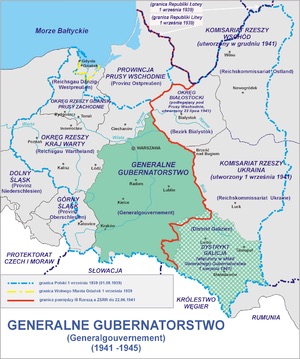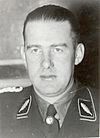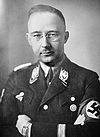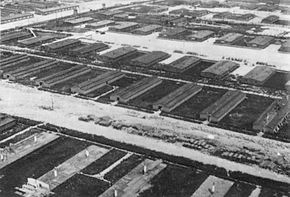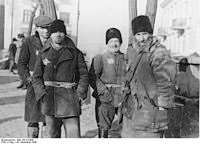Lublin, Poland
Nisko Plan
From Wikipedia, the free encyclopedia
The Nisko Plan,[1] also, the Lublin Plan,[2] or the Nisko-Lublin Plan[3] (German: Nisko und Lublin Plan),[4] was developed in September 1939 by the Nazi Schutzstaffel (SS) as the "territorial solution to the Jewish Question".[5] In contrast to similar Nazi "Madagascar" and other plans (invented before World War II),[6] the Nisko Plan was devised after the invasion of Poland, and implemented between October 1939 and April 1940 by the Germans setting up the so-called Lublin reservation[7] known also as the Nisko reservation[8] (Lublin Reservat,[9] or Nisko Reservat),[10] a concentration camp complex in the Generalgouvernement.[11] The plan and the reservation were named after the cities of Lublin and Nisko, which bordered the area, and would have become part of the complex after its envisioned though never realized enlargement.
When the Nazis implemented the plan, they set up a variety of forced labour camps adjacent to the reservation, with the reservation supplying the camps with workforce. These were various camps of the Burggraben project, intended to solidify the Nazi-Soviet demarcation line, and the Lublin-Lipowa camp supplying the local SS units.
The reservation idea was devised by Adolf Hitler with Nazi chief ideologist Alfred Rosenberg and Reichsführer-SS Heinrich Himmler, including active participation of SS-Obersturmbannführer and "architect of the Holocaust", Adolf Eichmann; as well as Hans Frank and Arthur Seyss-Inquart of the Generalgouvernement administration; and Heinrich Müller of the Gestapo. Odilo Globocnik, the former Gauleiter of Vienna, then SS and Police Leader of the Lublin district, implemented the plan and was in direct charge of both the reservation and the adjacent camps.
The Generalgouvernement in 1939 (dark green); Lublin is indicated in District of Galicia (bottom-right)
In total, about 95,000 Jews were deported to the Lublin reservation. The main camp of the entire complex, Belzec, became the first Nazi extermination camp of Operation Reinhard, with permanent gas chambers. Though the Burggraben camps were temporarily closed in late 1940, many of them were reactivated in 1941. Two other extermination camps, Sobibor and Majdanek, were later set up in the Lublin district also. The Lipowa camp became a subcamp of the latter in 1943. The Nisko Plan was abandoned for pragmatic reasons.
Background
The antisemitic regime in Nazi Germany intended to achieve a permanent solution to what they regarded as the "Jewish question". Before the "Final solution" was agreed upon during the Wannsee Conference of 1942, some Nazis had envisioned a territorial solution of the "Jewish question". However, except for the Nisko Plan, none of the territorial solutions progressed beyond the planning stage. Instead, the Nazi Germans implemented the near complete extermination of the European Jews through the Holocaust.
Planning
In late summer 1939, Nazi German dictator Adolf Hitler, with one of his foremost Nazi ideologues Alfred Rosenberg, developed the idea for a Jewish "reservation" (Judenreservat). The town of Lublin in Poland had been the focus of Nazi planners already since the early 1930s, after Herrmann Seiffert described it as the center of Jewish worldwide power and source of their genetic potential.[12] After Nazi Germany had defeated Poland in September 1939 and partitioned her with the Soviet Union, the Lublin area became part of the Generalgouvernement headed by Hans Frank.[13] Once under Nazi German control, the area was inspected by Frank's deputy Artur Seyss-Inquart in November 1939. He reported that - according to the local governor - the area, "swampy in its nature", would serve well as a reservation for Jews, and that "this action would cause [their] considerable decimation."[12] On 25 November, Frank informed the local administration that an influx of "millions of Jews" was proposed.[12] Also in November, Odilo Globocnik was put in charge of all issues regarding the Jews in the Lublin area, representing the SS as the area's SS and Police Leader.[12] Globocnik set up a department led by a Dr. Hofbauer to plan the settlement of the expected Jews and their conscription to forced labour.[12]
Lublin reservation
The Lublin reservation comprised an area of 300 to 400 square miles (780 to 1,000 km2) located between the Vistula and San rivers southeast of Lublin.[12] Adolf Eichmann, then head of the Central Office for Jewish Emigration for the Protectorate of Bohemia and Moravia, was the first to realize the Nisko Plan by deporting Jews to the Lublin reservation.[12][14] While initially the Jews of East Upper Silesia were to be deported, Eichmann expanded the program to include Jews from Mährisch-Ostrau in the Protectorate of Bohemia and Moravia and from Vienna.[15] Eichmann also set up a transit camp in nearby Nisko, a town on the western border of the Lublin district, from which the deportees were to be expelled eastward.[15]
The first Jews were shipped to Lublin on October 18, 1939. The first train loads consisted of Jews deported from Austria and the Protectorate of Bohemia and Moravia.[16] On October 19, when the second and third transports were prepared, Heinrich Müller, on behalf of SS head Heinrich Himmler,[15] ordered a suspension of further deportations.[15] Historian Christopher Browning noted that Himmler's decision must be seen in correlation with his new position as chief coordinator of the resettlement of ethnic Germans to the former Polish areas annexed by Nazi Germany, a position he held since 15 October. He suggested also that Himmler did not consider the deportation of Jews from all the Third Reich to be as urgent as providing space for the resettlement of ethnic Germans in Nazi Germany's new eastern provinces.[15]
This priority shift resulted in focusing on the expulsion of Jews from these provinces to the Lublin reservation,[15] the contemporary resettlement of about 30,000 ethnic Germans from the Lublin district in the opposite direction,[15] and the resettlement of Jews living within the Generalgouvernement to the eastern bank of the Vistula.[15] Hitler approved of this priority shift: While in early October he had envisioned the short-term expulsion of all Jews from Vienna and 300,000 Jews from the Altreich to the Lublin reservation, he in late October approved Himler's plans for deportation of 550,000 Jews from the new eastern provinces and all "Congress Poles", meaning Poles from the Soviet partition residing in the Third Reich, to the Lublin reservation.[15] While this would have resulted in short-term expulsions of one million people, this number was cut down for capacity reasons to 80,000 after intervention on 28 November 1939 by Reinhard Heydrich, chief of the Reich Main Security Office.[15]
The reservation was not kept secret; the local population was aware and the international press was reporting.[17] Reports in the Luxembourgian paper Luxemburger Wort of 12 November and the British paper The Times of 16 December 1939 both gave a total of 45,000 Jews deported to the reservation so far.[17] Also in December, the American paper The Spectator reported the reservation was enclosed by barbed wire on an area of fifty by sixty miles near Nisko and Lublin, and prepared for an intake of 1,945,000 Jews.[17]
An excerpt from a Luxemburger Wort report of November 1939 reads:
"Sometimes trains drive on for forty kilometres beyond Lublin and halt in the open country, where the Jews alight with their luggage and have to find themselves primitive accommodation in the surrounding villages."[18]
Historians estimate that by January 30, 1940, a total of 78,000 Jews had been deported to Lublin from Germany, Austria and Czechoslovakia.[19] This figure was given by Heydrich when he reported in Berlin in January. He stated the number would increase to 400,000 by the end of the year.[20] Among the Jews deported to the reservation in February 1940 were the Pomeranian Jews,[21] resulting in Gauleiter Franz Schwede-Coburg declaring his Pomeranian Gau the first Gau of the Altreich to be judenrein ("cleansed of Jews"). The deportees were put under the authority of the Judenrat in neighboring Lublin.[22] By April, when the reservation was dissolved, the total number of Jews who had been transported to Nisko had reached 95,000.[23]
Many deportees had died due to starvation, either during the transport[21] or during their stay in the reservation.[23] Additional deaths in the reservation were caused by typhus and typhoid fever epidemics, the lack of housing and any "sources of livelihood", a situation the local Jews were not able to ease, despite great efforts.[12]
Adjacent forced labour camps
Lublin-Lipowa
In the nearby city of Lublin, Jewish prisoners of war (POWs) who had served in the Polish armies were concentrated in the contemporary Lipowa camp ('ZAL Lipowa).[12] The camp was set up by SSPF Odilo Globocnik in December 1939 in Lublin's Lipowa Street No. 7.[24] While in December 1939 the first prisoners were forced to run toward the nearby Nazi-Soviet demarcation line while being shot at ("Lublin Death March"), conditions eased after January 1940 as the POWs were, like the deportees in the reservation, put under the aegis of the Lublin Judenrat and allowed considerable self-government.[12] The facilities of the camp served to supply the local SS units.[24]
In addition to the POWs, Lublin Jews were conscripted for forced labour in Lipowa.[25] For the most part, such Jews were not interned but continued to live in their apartments when off work.[25] The local Judenrat had to supply the workforce demanded by the SS.[25] If the Judenrat did not succeed in gathering enough Jews, SS units gathered the rest.[25] This brought about conflicts between Odilo Globocnik and governor Hans Frank, who complained that the forced recruitment of skilled Jewish workers by the SS was seriously interfering with the requirements of his civilian administration.[25]
Reconnaissance photograph of the Majdanek concentration camp (June 24, 1944) from the collections of the Majdanek Museum; lower half: the barracks under deconstruction with visible chimney stacks still standing and planks of wood piled up along the supply road; in the upper half, functioning barracks
From early 1940, some of the Jews deported to the Lublin area were held in the Lipowa camp.[25] These were deportees from the Altreich as well as from Reichsgau Danzig-West Prussia, Reichsgau Wartheland, and South East Prussia.[25] The Lipowa camp remained in place after the Lublin reservation was abandoned.[25] After January 1941, the Lublin Jews who earlier had resided outside the camp, were forced to live in the camp after its expansion.[25] Also in 1941, the camp was officially made part of the SS enterprise Deutsche Ausrüstungswerke (DAW). Effectively it remained outside DAW control by staying under the direct aegis of Globocnik.[26] This changed only in 1943, after Globocnik resigned as the Lublin district SS-and-Police Leader and the camp became the sub-camp of Majdanek concentration camp complex.[26]
Burggraben project
When the Lublin reservation was planned, the reservation was to be combined with several forced labour camps (Zwangsarbeiterlager, ZALs) along the Nazi-Soviet demarcation line.[27] The reservation was to supply the ZALs with workforce to erect military defense facilities, including a large anti-tank ditch along the demarcation line code-named Burggraben ("fortress' ditch").[27] While initially the SS headquarters had envisioned four large camps, governor Hans Frank refused to finance such a large project.[27] Thus Odilo Globocnik decided instead to set up various small camps run at lowest cost.[27] This resulted in desperate conditions: the inmates were crowded in dark and dirty rooms with no glass in the windows, had to sleep on the floor, the sick were not separated from the healthy, and the supply of food, water and soap was insufficient.[27] About 30% of the inmates did not have shoes, pants, or shirts.[27] This situation caused a rapid spread of lice and diseases.[27] Of all Burggraben-ZAL-camps, the later extermination camp Bełżec was the main camp.[27]
The Burggraben project was abandoned in late 1940 due to pressure asserted by the German military (Wehrmacht), who regarded it to be of no military use.[27] Heinrich Himmler, however, disagreed and continued to support the project.[27] While the Burggraben camps had been closed down in late 1940, some were reinforced in spring 1941 on Himmler's initiative and again put under Globocnik's supervision to finish the anti-tank ditch.[27]
Suspension and abandonment of the reservation
On 23 March 1940, Hermann Göring with Himmler's approval put a hold on the Nisko Plan, and by the end of April, final abandonment was announced by Krüger.[12][28] Reasons for the abandonment included Frank's refusal to accept further influx of deportees into "his" Generalgouvernement which he viewed as overcrowded, and the fear the Nazis would lose international reputation due to the international press reports.[12] The rationale of the abandonment was not one of principle, but a pragmatic one, and deportations continued though in slower pace.[12]
Consequences of the plan abandonment[
Ghettoization
Jews in Lublin, December 1939
In the Nazi German controlled towns, the abandonment of the reservation led to a situation where Jews already concentrated for deportation were stuck, thus large sealed Jewish urban ghettos were formed as a more permanent institution pending a new destination for deportation.[29] In the Lublin area, the situation initially differed: Because of the envisioned and implemented reservation plans, Jews in this area had not been herded to urban ghettos, but had been dispersed from the urban centers into the rural areas.[29] While the remaining 40,000 Jews of Lublin were forced into the Lublin Ghetto in May 1940,[30][31] ghettos were not established in the provincial towns.[29] The concentration of the Lublin Jews in 1940 was based solely on Globocnik's dislike of Jews settling near his staff headquarters.[31] The only Jewish ghettos established in all of the Generalgouvernement in 1940 were those of Kraków and Warsaw.[31] In Lublin, a ghetto was established for the remaining Jews on 24 March 1941, while 10,000 Jews had been expelled from Lublin in early March to the rural surroundings of the town.[31] This measure was driven by the need of the military, which was preparing for Operation Barbarossa, for housing.[31] In all the Lublin district, the only other ghetto established until February 1942 was the Jewish ghetto of Piaski.[31] Yet, already in October and December 1941, the local administration and the Sicherheitspolizei headquarters issued decrees that Jews were to be executed when caught leaving the Jewish districts, also anyone was to be executed who hosted a Jew outside the permitted areas.[32]
Extermination camps
Further information: Nazi extermination camps, Holocaust, and Aktion Reinhardt
On August 15, 1940, after the Fall of France, Nazi leaders focused on developing a "territorial solution of the Jewish question" in French Madagascar.[28] However, this plan was never implemented as it proved to be infeasible. During the Wannsee Conference in January 1942, the heads of the Nazi regime finally decided to resolve the "Jewish question" by extermination rather than deportation. Of the Nazi extermination camps, Belzec, Majdanek, and Sobibor were all set up in the Lublin district.
The Belzec extermination camp was established in November 1941 near the forced labour camp by Odilo Globocnik under direct order of Heinrich Himmler.[33] It was constructed as part of Aktion Reinhardt, the plan to murder all the Jews within the Generalgouvernment.[33]
Globocnik was given the unconditional backing of Himmler. But his hard-line enforcement of Nazi racial ideology brought him into conflict with the Hans Frank. Globocnik, continued to control the Lublin district until Aktion Reinhardt finished in late 1943. Approximately two million Jews died in Belzec, Maidanek and Sobibor (including Treblinka) in the course of the "Aktion".[34]
Role in Holocaust historiography
The Nisko Plan is an example used in the functionalism versus intentionalism debate. In Christopher Browning's article, "Nazi Resettlement Policy and the Search for a Solution to the Jewish Question, 1939-1941", he focused on the territorial solutions and how they were interpreted for different use.[35] On October 24, 1939, The Times noted that the German plan to create a Jewish state was cynical and would surely doom the Jews to famine.[36] Most historians of Nazi Germany and the Holocaust have concluded that the Nisko Plan was integrally related to Hitler's other programs and intent to destroy the Jews in Europe. Thus they hold that the Nisko Plan was a preface to the Final Solution.[15]
Browning has suggested that the Nisko Plan was an example that Hitler did not have previous intentions for the gassing of the Jews. He contends that the Nisko (or Lublin Plan), Madagascar Plan and Pripet Marsh Plan, all served as territorial solutions to the Jewish question, but were separate from the Final Solution. Mainstream historians contend that Hitler and his government created an issue out of the "Jewish question", raised anti-semitism in Germany, and created the need for a "territorial solution" and genocide.[15]



